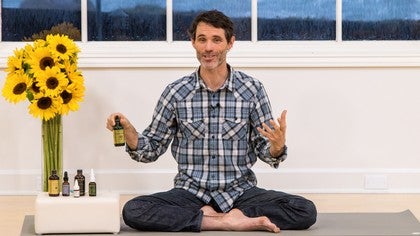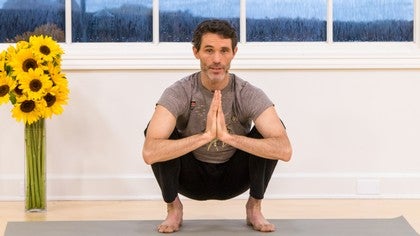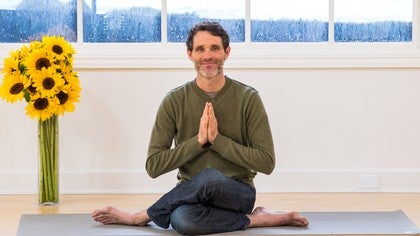Description
About This Video
Transcript
Read Full Transcript
(waves washing ashore) In my clinical experience, one of the most critical things that anybody can do both for their physiological health as well as their mental emotional balance is to have a morning routine. And I use this extensively with all of my patients, and the practices we're gonna get into today are from Ayurveda primarily and yoga. There's a poem from Rumi that I think speaks beautifully to the essence of the importance of morning and the way that we spend our mornings which goes something like this. Today like everyday we wake frightened and empty. Don't open the door to the study and begin reading.
Take down a musical instrument. Let the beauty we love be what we do. There are hundreds of ways to kneel and kiss the ground. And so the instrument is you. And in the both from the Ayurvedic and the Yogic perspectives we tune the instrument of the body to be a sort of instrument of spirit, an instrument of inspiration, an instrument of action.
And so in that way there's an understanding that what you're going to do in your day begins the moment that you wake up. And... Intention setting, visualization are very important practices as well as working with the five senses as a preliminary to yoga practice. And so from the Ayurvedic perspective it has a very basic kind of health directive to it. Which is your sense organs are areas where you are exposed to the environment, they're very delicate areas, and you want to avoid infection of course of any of those areas, so you do things to keep them clean.
But it also has deeper ramifications in the sense that when you do this kind of practice with clearing the senses, it's very powerful for focusing your mind, for grounding your nervous system and actually balancing your emotions. From the Yogic perspective, the five senses are said to be the main portals through which our prana, our life force, is either preserved and conserved or expressed and depleted. And so by cleaning the senses, by paying attention to the senses we're preparing ourselves to move into the day with as much readiness as possible for seeing things clearly and then the actions that follow from that clarity. And so, let's get into it. And so the first thing is from an Ayurvedic perspective waking up with the sun is ideal because you're aligning yourself with a natural rhythm and as the Rumi poem beautifully points out, a lot of times we wake up and there's a quality of insecurity there that we want to work with and that's partly because you're literally being reborn.
You're going from being in unconscious to waking up, and your life force is being organized by your dreams and your unconscious state in a way that may feel quite disorganized when you wake up. And so, it's very important to direct your prana. And one of the most core ways that you do that is to set your intention for the day. Which can be done in a religious context with prayer, it can be done in a non-religious context with setting intention. It can be done very powerfully by just simply going through a practice of visualizing your day.
So let's do the visualization practice because I think it's very neutral and it also is very potent. So for a moment, close your eyes. Take a couple of deep grounding breaths down into your belly. Feel your shoulders relax and your eyes and your jaw relax. Feel your hold body ground.
And whether it's the beginning of the day that you're watching this, or it's the end of the day, just imagine what's coming next in the next few hours for your day. And... Take time to visualize the most smooth graceful rhythmic transition, the most successful transitions for getting what you want to get done, done. So take a few breaths doing that. Just imagine everything going perfect.
How would that look, and more importantly how would that feel? And then with a new few more breaths, start to picture yourself dealing with any challenges that might arise in that process. How will you gracefully, skillfully maneuver through any challenges to your sort of perfect day or perfect night and how would it feel most importantly. How are you gonna feel as you meet those challenges? And just taking two more breaths with that.
And now finally for three more breaths picture how your actions can be a benefit to helping those who you're in with relationship to stay in balance. Those who you work with to stay in balance, those who you serve to stay in balance as well. The Buddhists have a beautiful prayer which is to say very simply may all of my actions be of benefit to others. And then opening your eyes. Okay, so next what I'd like to do is get into some five senses Ayurvedic wonderment.
Which is cleaning the senses which is also kind of dressing them up. You know, it actually feels incredible and now that I've been doing this for years in my own morning practice, it's like I really feel like it has a much more profound effect than just cleaning the senses. And so first, we're gonna work with the eyes. And you can use any kind of a neutral solution, like this isn't Visine or some kind of get the red out of kind of thing, this is just a moistening solution, it's a neutral borate solution, and there's a number of products like that on the market. Traditionally it was usually a saltwater solution, sometimes with a little bit of rosewater put in it.
And so basically what I do is I will come and I just put, I'll tip the head back and I'll just put in a drop in each eye. And it feels incredible. And it has a wonderful cooling sensation for the eyes. Usually you know, in the morning sometimes I'll let it just dry, but it's nice to kind of mop up any drops that you know, get around the eyes. Sometimes what I do too is I'll do the cleaning with the solution and then I'll just wash my face with some water.
And then the next one that I'd like to get into is the ears. And so there's a... The Ayerveds completely love oil. Oil for everything. And the fact is that oil, natural vegetable oils and seed oils, especially things like sesame oil are naturally antibacterial and antifungal.
They're also moistening and cleansing to the skin so it actually, for all your mucus membranes and the surface of your skin, your body just loves it and it actually often cleans your skin as well or better than detergent based soaps which can be very harsh on the skin and cause sort of reactions or those kinds of things that aren't great. So, the first thing that I'll do is then I'll just start to gently massage my ears, so try that. Now, there's a kind of area at the top of the ear where your thumb fits in naturally, it's called the triangular fossa, there's a very powerful acupuncture point there. And then I'll go down and just gently stretch my ears. You know, kind of get into it and you know you're doing it right if your eyes kind of naturally soften and get a little heavier because your ears are connected to your vagus nerve and the vagus nerve is one of the most direct connections to the relaxation response in the body.
And then to finish... I'll take a little bit of oil, put it on my finger and just put a drop of oil inside of my ear. You know, kind of in the canal. And this is really wonderful for protecting you from infections, getting water trapped in your ear, because the oil and water separate so it actually keeps the water from getting in, and it also has a wonderful effect on grounding you. Ayurveda recommends oiling the ears if your memory is not working as well as you think it should be.
So. That's a little bit on the ears, all these things are very simple and once you really get it it only takes you five minutes to do all of this stuff, so it isn't like it's gonna add a tremendous amount of time to your morning routine. The next one is taking care of the nose. And of course there is the Neti Pot. You know, the Neti Pot I think is very well known in the yoga community.
Where you take a saline solution and you're running saline through the sinus in both directions. And I wanted to introduce something that is maybe a lesser known practice for clearing the nose, protecting the nose, and especially during the winter time is a really wonderful protector for cold and flu. And this is actually using oil in the nose, and it's called Nasya oil. And Nasya is the Sanskrit word for nose. This is a newfangled version of it.
Most of the time what you'll do is, you'll use a dropper bottle like this one and basically you can either put a few drops in your nose by tipping your head back or put a little bit on a finger and swab it inside the nose, but this is like a spray. And so there's some other products that exist on the market that are Xylitol based that are exactly like this for spraying in the nose and they're wonderful for protecting against sinus infection. But in this particular oil there's probably 40 different herbs and they all exert some kind of juju inside the nose that's very good. And so... I love it.
And I'd always feel like as soon as I do it, it has this grounding, soothing effect. And you know, maybe you're not used to putting oil up your nose and it might sound very exotic and kind of weird, but don't knock it til you try it. So, the basic thing is like this. I took off the cap and then I'm just gonna lean back and I just... Squirt...
The oil into the nose. And once it's in there tip the head back and kind of... Wick the oil a little higher in your sinuses. So that's a little bit of self care for the nose. If you are somebody that has allergies or suffers from recurrent sinus infections or dryness of the sinuses, highly highly recommend that you use the Nasya oil.
The Neti Pot is wonderful for cleansing, so if there's a lot of pollen or dust or environmental toxins floating around, it's really wonderful as a cleansing, but the oil is actually more nourishing, so I think it's actually better for an everyday kind of thing and has a wonderful medicinal value for people who really need it, but it also has a protective value for just everybody else. Like, even if you're not having sinus issues. So that's the nose. And then moving on to the mouth, and the famous tongue scraper. This is, you know, I found this one at a health food store.
The basic idea is you put it in the back of your mouth and you run forward and you put just enough pressure so that it's actually scraping the tongue and what that does is you have these crypts in your tongue that are little pores and over the night and residue from what you've been eating and then just bacterial growth that occurs during sleep can build up in those places and it contributes to things like bad breath, it can actually contribute to giving you nausea and even those kind of things, and so Ayurveda promotes using the tongue scraper first thing in the morning for mouth health in general. And it's that simple. You just maybe scrape once or twice then clean it. And then you're done. One thing that is very popular these days which is attributed to Ayurveda and it may or may not be Ayurvedic is the oil pulling.
But Ayurveda is absolutely oil positive so things like sesame oil, olive oil, are wonderful to put in the mouth and swish around because just like any of the other tissues in the head, the gums, the teeth love the oil. It actually is very soothing and cleansing for the whole mouth. So... I'm not gonna do it, but remember it. And then finally is oiling the skin.
And now there's a whole bunch to this. Sharda has literally every kind of oil for your Dosha types, so if you don't know your Ayurvedic constitutional type, you can go to my website doctorblossom.com and take a free test to learn what that is, there's lots of those kind of tests out there online so by no means is mine the only place to do it. And so the oils that Sharda makes, again have about 40 herbs in them, they're cooked for about a month so they have a very wonderful penetration quality and Horvat oil which is really useful for calming yourself down and just basically grounding is one of my favorites especially if you've had a very intense or stimulating day. So you can do this at night but you can also do it in the morning and it actually creates a kind of beautiful gossamer around you to sort of cushion you a little bit from the inevitable, you know, blows and winds of change in the day. And so the basic idea is that you would take the oil and some people get fancy and they have a little metal dish and they'll put a sort of votive candle under it and warm the oil up, but if you put it on your hands and rub your hands together you can also warm the oil up, but I've been doing it for so long that I do it quickly.
Plus I have children, so I can't make it such a grand event, I have to be very direct about it. And so I'll put it on my hands, I'll rub it, and then it's very much a kind of lymphatic type of thing which means you're gonna move from the extremities back to the core. So I'll start with my feet and you get in between your toes because again, these oils are antifungals so if you want to prevent foot fungus and other things that can come into the feet and the toes, it's wonderful for preventing that. And then I'll work my way up and the idea is that on the long bones it's a stroke that's sort of with the bone towards the core of the body. When you get to the joints, you do circles.
So then it would be like this, and you want to get it everywhere. And then the knee would be circles, and then the thigh would be another place where you're doing strokes and then the hip is a circle, the tailbone's a circle, all of the joints. You don't need to put a ton on. Actually, it spreads very well so it's nice to massage yourself gently and spread it out. And then once you get into the shower or the bath, the warm water will actually cause your pores to open even more and the oil will be drawn into the body even more deeply.
So when you get out of the shower or the bath, you'll actually find that a lot of it is actually soaked in already and you won't have this heavy layer of oil. Although it is a good idea to use towels that you know are potentially going to get a little oily. And the best remedy for laundering a towel that has some oil is actually to add some vinegar and some baking soda to your laundry detergent and that does a, kind of a supercharges the capacity to pull the oil out. And so another layer of the skin that's really important is of course the face. And so it's funny in America because everybody that gets acne or some kind of treatment for the skin, they're giving usually medications that dry up the oil on the skin so it sort of turns off the sebaceous glands.
Ayurveda actually takes almost like a diametric approach to healing the skin which is we'll use oils that have been steeped in antibacterial kind of substances like neem or things like that where you can cure any kind of infection that might be happening in the pores, but you also are oiling the skin because actually when you have some nice oil the pores, the sebaceous glands get the idea that they have the day off and they actually dry up because there's plentiful oil on the skin, and the oil doesn't lead to clogging which I think some people intuitively would associate, oh my pores are having problems I wouldn't want to clog them up with more oil. And so another thing I highly recommend if you're having skin stuff is to look very closely at your diet. Because actually a lot of skin disorders are inflammatory immune reactions to indigestible food and we can all get into those kind of habits just because we're used to eating a certain thing, and actually through my life I've now noticed that there have been seasons when I can digest a certain kind of food very easily, and there's other times in my life, periods in my life, where that same food is not very digestible and doesn't agree with me so you need to be inquisitive about a dietary relationship to skin stuff and if you have teenagers who are having skin stuff definitely look into the food possibility for helping to clear that up. Now finally, you have the scalp. And the scalp is...
It's a very, very important area of the head because there's all this lymphatic circulation right under the surface. So oiling the scalp, little bit of oil on the scalp is wonderful for any dandruff and those kind of things, but even more importantly is just something where in the morning you can use, this is a special oil this is Sharda's hair elixir which I love. I'm 46, the grey is coming inexorably. And so this is the kind of oil that actually is supposed to help you keep your hair and keep it looking the color it's been for as long as you've been alive. And so I'm gonna show you guys a little bit about how to put this on.
And so basically with the hair elixir here, what's nice to do is to take a little bit. You know, just a small amount. And then I'll put it right on the crown of my head. And it always has a nice kind of cool feeling when you do that, and then I'll rub it in. And so from an Ayurvedic perspective, putting oil on the crown of your head is another thing that grounds you for the day because it sort of, the crown is sort of the exit point for moving into astral and mystical territory and if you have to go to the grocery store and drive around and do stuff, it's better to keep your mundane awareness very well stabilized and grounded.
So once you have the oil on the crown of your head, it's wonderful then to just massage it around. You can kind of gently massage it, and you can add oil to other parts of the scalp too. Especially if you have a dry scalp. And once you're doing sort of small circles to massage the oil in, there's a lymphatic massage where you sort of brush the hair from front to back like this and you might do it eight or ten times, and you get this cool Leif Garrett feathered 70's look. After that, you've kind of stimulated the lymph and the head which is very, very important for actually relieving minor headaches for also helping all the sense organs to function.
But a natural way to kind of clear that is then to gently massage the throat, massage the side of the neck, massage the back of the neck, to move the lymphatic into the body more easily as well. As an extension of lymphatic massage, I'd like to show you guys a series of joint rolls and so this will be a practice we'll get up for. So come to standing and we'll do this together. These are all really simple movements and I kind of intentionally didn't wear yoga clothes just to make it completely clear that you don't have to get real fancy about how you're dressed to do these practices. So the first one is going to be some ankle circles.
And so the lymphatic system, one of the main pumps of that system is actually in your hip and your ankle and this particular practice is excellent for that. And so you can take one foot back, it doesn't matter which and then you just start turning little circles over the tops of the toes. I'm gonna do eight in both directions. Six, seven... Eight.
And then the other way. Five. Try to make it feel like you can really feel your thigh bones swinging freely in your head. And that's number eight. Then I'll switch.
Turning one, two... Three, four... Five, six... Seven, eight... Other way.
One, two... Four, five, six... Seven, eight. And then you get a nice stable stance, and you're gonna make little circles with your nose. And it's important to think about turning your nose because that's the gentlest way to do these motions for your neck.
If you have any pre-existing neck tension or irritation or injury, be very gentle with this. Seven... Eight. Other way. And as you do this, keep your eyes open so that you don't lose your balance.
Seven... Eight. I apologize if there's any fuzzy math on the counts on this. Inhale. And then you start to kind of roll your shoulders back and forth, it feels great.
And what you try to do is like make it so it feels like you're giving yourself a shoulder massage, okay so that's eight. So as you do it don't get too crazy about it because you'll use a lot of muscles and it doesn't reduce tension. It's actually, you have to be kind of little bit understated about it to get it to do the job with the shoulders. And then the next one if a group of rolls that are for your wrist, but the wrist like the ankles are very important for the lymphatic circulation into the chest. So as I'm turning that...
And then I switch directions. Five... Seven... Eight. And then your next one is a gentle twisting action.
You're gonna just swing and as you do this, try to be as relaxed as possible with your chest and your abdomen. Keep your feet really grounded. But more or less, you're just being loose, yeah? Just be relaxed. And I usually do two times eight cause I count one twist to both directions as...
Yeah, and then you come back. And then you do some hip swings. And now the hidden thing about the hip swings is that when you swing your hips this way it actually massages the base of your skull. It feels good. And again, don't get too busy with making it big or any other thing.
There's different kinds of people in the world. There's people that get all like Law and Order with it where they're like... Don't do that. And then there are people that have been to one too many Phish concerts and they're like this. That's not advisable either because what you're actually trying to do is swing the hips in a way where it's gonna massage the cerebral spinal fluids through the whole spine, and so you need to have this kind of relaxed jaw, neck kind of feeling that you go into as you do it.
Yeah, and if it feels really pleasant up at the base of your skull, this area is an area that holds a lot of tension in a lot of people so if you can do this swing in a way where it actually feels like it loosened up right where your skull meets the top of your spine, that's the sort of advanced skillset for that one. Then you step in, you bring your feet together and your hands down on your knees, and this is again coming back to the ankles and you're gonna turn both of them along with the knees. But it's really focus your attention on making these beautiful circles with the ankle. This one because of the positioning also has a nice gentle kind of stretching effect on the calves. Just make sure that your neck and your low back are happy in whatever position you have them in.
Seven... Eight. And then lastly, is a kind of standing wave where you take your tailbone back and then you tuck it under. Sort of curling this way. And you roll the wave up your spine.
So I'll show it from the side, it's like this. Your tailbone comes back. And you curl it under to roll it up. Just keep the weight balanced on your feet for this one. And you can do as many repetitions as you like.
Usually around eight is a good number. And as I was saying with the head, the lymphatic system is often called the sewer system of the body because it's related to good elimination and so much about morning routine is actually having good elimination. And so we're gonna cover that in another class, but basically suffice to say that when you get your lymph moving it actually brings down inflammation systemically in your system. And nowadays inflammation is being really tied into every disease process ranging from heart disease to cancer to arthritis and these kinds of things and so this little sequence is very simple and very safe but it has a real potent effect especially if you engage it on a daily basis. So, Namaste.
Prana: Robert Svoboda & Scott Blossom
Comments
Thank you again!
You need to be a subscriber to post a comment.
Please Log In or Create an Account to start your free trial.














